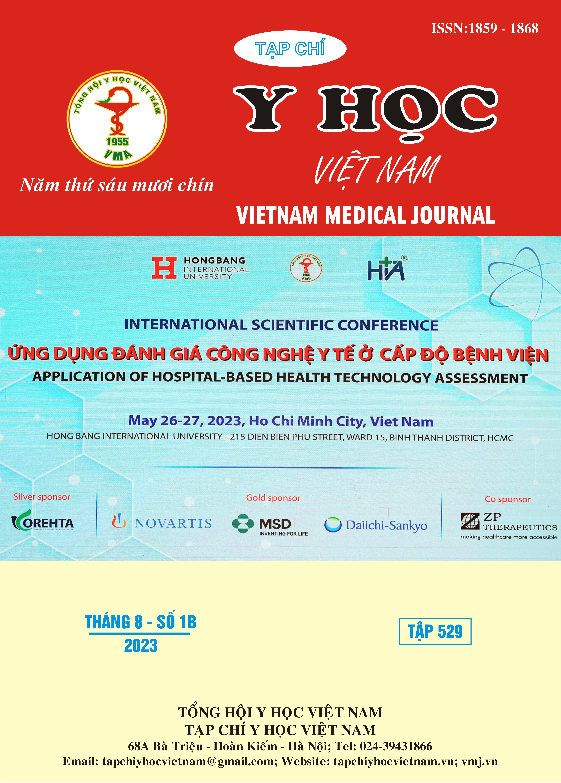EVALUATION OF TOTAL GASTRECTOMY FOR GASTRIC CARCINOMA IN K HOSPITAL
Main Article Content
Abstract
Objectives: To describe the clinical, paraclinical characteristics and surgical outcomes of total gastrectomy for gastric adenocarcinoma patients at Quan Su General Surgery Department - K Hospital. Patients and methods: A total 66 gastric cancer patients treated with open total gastrectomy at Quan Su General Surgery Department - K Hospital retrospectively reviewed during the period from 01/2018 - 01/2022. Results: Of 66 patients, the mean age: 60.98 ± 9.87 (39 - 70 years old); male/female ratio = 2.88/1; 91% of patients admitted for epigastric pain; common clinical symptoms: epigastric pain (95.5%), loss of appetite (57.6%), weight loss (27.3%), nausea/vomiting (25.8%); 48.5% of patients had a history of gastric ulcer; the main course of disease was less than 3 months (51.5%). The most common tumor location was the body (50%); histopathology: glandular adenocarcinoma 72.7%, poorly cohesive adenocarcinoma (12.1%), ring cell adenocarcinoma (10.6%), mucinous glandular adenocarcinoma (3%); most had lymphatic invasion (59%) and perineural invasion (59%). The degree of tumor invasion was mostly T4a (50%), T3: 30.3%, T4b: 7.6%, T1b: 4.5%; 59.1% of patients had lymph node metastases, average number of lymph nodes removed: 14.88 ± 8.24. 6% of patients underwent extended total gastrectomy; 100% of patients restored gastrointestinal circulation according to Roux-en-Y; median time: 4.02 ± 0.75 days; median time to drain removal: 8.35 ± 0.94 days; postoperative hospital stay: 11.14 ± 1.51 days; postoperative complications were 15.2%, including pneumonia in 4.6%, no patient underwent reoperation and there was no postoperative mortality; overall median survival time: 46.9 months. Conclusion: Radical surgery for gastric adenocarcinoma by total gastrectomy is safe and can be performed for patients, however, it is necessary to carefully evaluate the stage of the disease, general condition index and accompanying underlying diseases.
Article Details
Keywords
gastric cancer, total gastrectomy
References
2. Nguyễn Phúc Kiên (2015). Đánh giá kết quả phẫu thuật ung thư dạ dày sớm tại Bệnh viện Việt Đức. Luận văn bác sĩ chuyên khoa cấp II, Trường đại học Y Hà Nội.
3. Nguyễn Đức Huân (2006). Nghiên cứu đặc điểm lâm sàng, mô bệnh học và hóa mô miễn dịch của ung thư dạ dày tại bệnh viện K. Luận văn Bác sỹ nội trú, Đại học Y Hà Nội, Hà Nội.
4. Nguyễn Văn Long (2011). Đánh giá kết quả kiểu nối Roux-en- Y trong cắt toàn bộ dạ dày do ung thư. Y Học TP. Hồ Chí Minh. Tập 15. Phụ bản của Số 4.
5. Nguyễn Trọng Hảo và Trần Thiện Trung (2013). Các tai biến và biến chứng sau cắt toàn bộ dạ dày. Y Học TP. Hồ Chí Minh. Tập 17, Phụ bản của Số 4.
6. Sano T., Coit D. G., Kim H. H. et al. (2017). Proposal of a new stage grouping of gastric cancer for TNM classification: International Gastric Cancer Association staging project. Gastric cancer, 20, 217-225.
7. Gennari L, Bozzetti F, Bonfanti G, et al. (1986). Subtotal versus total gastrectomy for cancer of the lower two-thirds of the stomach: a new approach to an old problem. Br J Surg. 73(7):534-538.
8. Andreollo NA, Lopes LR, Coelho Neto J de S (2011). Postoperative complications after total gastrectomy in the gastric cancer: analysis of 300 patients. ABCD Arq Bras Cir Dig São Paulo. 24:126-130.
9. Roh C., Choi S., Seo W., et al. (2021). Incidence and treatment outcomes of leakage after gastrectomy for gastric cancer: Experience of 14,075 patients from a large volume centre. European journal of surgical oncology. Feb 25.


